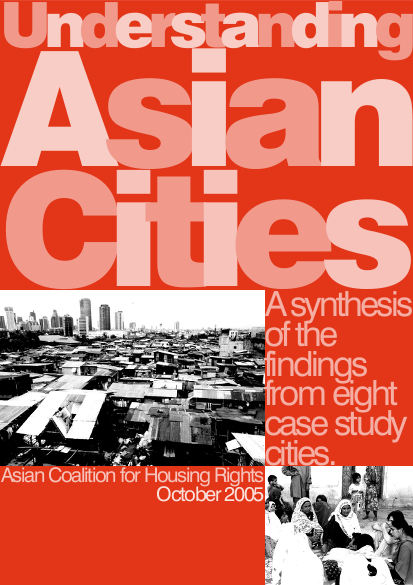
The decision for creating the Asian Coalition for Housing Rights (ACHR) was taken in 1987. Its founding members were professionals and NGOs working with poor communities in Asian cities. The organization was formalized in 1989 in Bangkok. Conditions at the local and international level at that time were very different from what they are today. The ACHR senior members have been very conscious of this reality and as a result have, over the years, stressed the need for understanding the changes that have taken place in the last decade and a half in Asian cities.
As a result, it was decided in the first quarter of 2003 to carry out a research on a number of Asian cities, so as to identify the process of socio-economic, physical and institutional change that has taken place since the ACHR was founded; the actors involved in this change; and the effect of this change on disadvantaged communities and interest groups. Eight Asian cities and eight researchers were identified for the purpose of this research. The case study cities are: Muntinlupa (a municipality in Metro Manila), Beijing, Hanoi, Phnom Penh, Chiang Mai, Surabaya, Pune and Karachi. The objectives of this research and the terms of reference for it are given on page 2, along with the names of the researchers. All of the researchers did not strictly follow the terms of reference. However, an enormous amount of material, running into hundreds of pages, regarding these cities has been generated and is available with the ACHR secretariat. The research and logistics related to the Asian cities project have been funded by the German funding agency Misereor.
During the period of the research, a number of meetings were held for discussions between the researchers. An introductory meeting was held in Bangkok in June 2003, followed by additional meetings in Bangkok and Hanoi. At these meetings, researchers presented the findings of their research and identified differences and similarities between these cities. A final meeting was held in Bangkok in October 2004. David Satterthwaite, from the International Institute for Environment and Development (IIED) in UK, was requested to facilitate this final meeting and to prepare a synthesis of the findings of the eight city case studies. This synthesis forms the subject of this publication.
The research has identified many differences between the eight cities. However, there are a number of strong similarities which are the result not only of how these cities have evolved historically but also of the major changes that have taken place in the world in the 1990s. These changes are the result of structural adjustment, the WTO regime and the dominance of the culture and institutions of globalization in the development policies (or lack of them) at the national level.
Links
Resource collections
- Topics
- UN Habitat - Urban Response Collection
- Urban Response - Urban Crisis Preparedness and Risk Reduction
- Urban Response Collection - Community Engagement and Social Cohesion
- Urban Response Collection - Economic Recovery
- Urban Response Collection - Environment and Climate Change
- Urban Response Collection - Housing, Land and Property
- Urban Response Collection - Urban Crisis Response, Recovery and Reconstruction
- Urban Response Collection - Urban Resilience